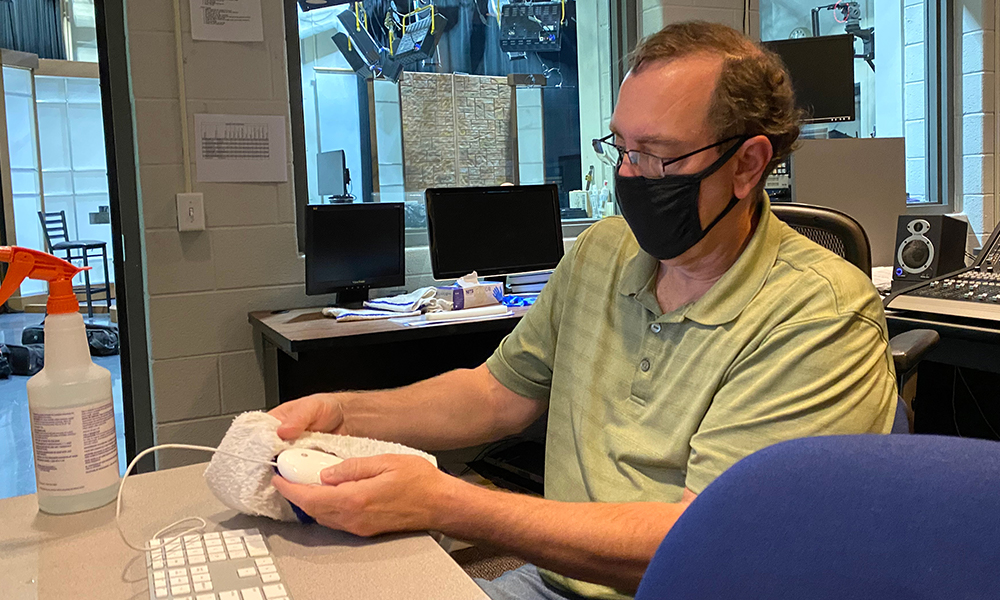SMAD innovates to keep students safe and focused on learning
Media Arts and Design
By Jessica Kronzer, staff writer
SMAD has employed new procedures and technologies this fall to try to prevent the spread of COVID-19, while professors also are finding ways to facilitate SMAD’s learning objectives virtually.
Such flexibility and safety precautions will remain important as JMU plans to bring students back to campus for most classes starting Oct. 5.
Gwyneth Mellinger, SMAD’s director, encouraged students to be patient with their professors, especially as the university has switched from on-campus classes to almost exclusively online learning starting Sept. 7 and now prepares to bring many of those courses back into the classroom Oct. 5. The university announced that classes with 50 or fewer students will shift back to hybrid or face-to-face at that time.
“Faculty have been planning for the fall semester for a couple of months, and nobody thought we were going to be online as quickly as we are,” Mellinger said. “Faculty members are going to do whatever they can to make sure that students aren't disadvantaged.”
In addition to the two university-wide cleaning breaks for Harrison Hall classrooms each day, John Gruver, SMAD's network and lab manager, and Jon Wenger, SMAD's chief engineer, clean keyboards for the SMAD lab Macs.
The building also has one-way hallways to control traffic and has fewer benches and tables in the halls to discourage congregating. Mellinger said she was encouraged by students who followed social distancing measures while in Harrison Hall.
“I can't say what people were doing after hours but I was so impressed,” Mellinger said. “I never saw a single student without a mask or bunched up next to somebody in person.”
The department ordered a UVC sanitizing unit that will use light to clean equipment efficiently. John Hodges, a SMAD instructor and the department’s technology manager, said when students check out equipment, they often receive bags with 25 separate items, such as cords, batteries and other attachments.
Some of these items cannot be cleaned with a wet cloth, and the process of cleaning each piece by hand would be time-consuming and unlikely to reach every surface. Instead, the UVC sanitizing unit will expedite this process and ensure any student using SMAD’s technology will receive clean equipment.
The SMAD checkout room and labs are open to students to give them access to necessary software and equipment for classes. Around half a dozen classes will continue to have some instruction on campus because of their technology needs.
“This entire semester … we will still be here with the studio open, with the checkout room open, with the labs open, so the students have access to the technology if they are still here in Harrisonburg and participating in a face to face class or even if their classes move totally online,” Hodges said.
Teaching and learning go on no matter what
Mellinger said after the first five days of classes at the start of the semester, about 100 SMAD students had reported to their professors that they were quarantining because they had tested positive for COVID-19, had been exposed to someone experiencing symptoms or had exhibited symptoms and were awaiting a test.
Students in quarantine could join classes virtually. But the number of students attending class online while others attended in person created an added challenge for professors.
Hodges ran into this issue while teaching SMAD 202. Because the class is focused on audio-visual storytelling, Hodges gave the students attending via WebEx a tour of the studio equipment using close-up shots with his iPad.
Many SMAD professors, like Hodges, planned for the university to continue in-person classes for longer and designed their syllabus around the idea that the university would eventually move online. Some professors front-loaded their course schedule with in-person demonstrations or rearranged their plans to emphasize use of equipment at the beginning of the semester.
After the university announced, it would be temporarily move to online instruction for most classes, Hodges moved his studio training to the end of the semester, with hopes that students will return to campus. He has always allowed students to film one project with their phone, but other professors have now extended that same flexibility to students who cannot check out cameras from campus.
Many professors teach their classes synchronously online, so they meet on WebEx or Zoom during their normal class times. Professors have employed video recording and sharing services, such as TechSmith’s Knowmia. Last spring semester, Hodges worked with the library to make videos to help professors use online tools.
“Our faculty tend to be a little bit more comfortable with technology, and I think people are learning how to use WebEx in new ways, not just showing up and talking into the computers,” Mellinger said.
Having an effect outside Harrison Hall
SMAD professors also have used their skills and know-how to help the campus and community amid the pandemic.
In the spring, Adrienne Hooker, a SMAD professor volunteered to use 3D printers to make face shields for the local hospital workers when personal protective equipment was in low production. After sending the group prototypes, she worked with the library to fulfill an order of 1,200 shields.
Hooker said SMAD students and faculty have played vital roles in serving the public, and specifically praised the student journalists at The Breeze for their reporting on the effect of COVID-19 at JMU and the university’s response.
“I think we're trying to help as much as we can,” Hooker said. “And that might be information to the public, or it might be actually giving the public what they need to stay safe.”
